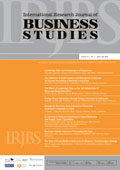Article Metrics |
|
|
Impact of Corporate Governance on Corporate Sustainable Growth
Abstract
It is believed that good corporate governance practices assist significantly in uplifting corporate performance, and brings in business success and sustainability. This study aims to shed light on the impact of corporate governance practices on corporate sustainable growth in India. A sample size of leading 139 non-financial companies listed in NSE for five years has been used in this study. Using longitudinal data analysis, the findings of the study suggest that Board Size (BS) and the Board Independence (B-IND) exercise strong influence in explaining
the Corporate Sustainable Growth in India after controlling the effect of Leverage (LEV).
Keywords:
corporate sustainable growth, corporate governance, longitudinal data analysis,
control variable, India.
* Department of Commerce, The University of Burdwan, West Bengal, and St. Xavier’s University, Kolkata, India
**Department of Commerce, The University of Burdwan, West Bengal, India.
Full Text:
References
Adams, R. B., & Ferreira, D. (2009).Women in the Boardroom and Their Impact on Governance and Performance. Journal of Financial Economics, 94(2), 291 309.
Ahren, K.R. & Dittmar, A. (2012). The Changing of the Boards: The Impact on Firm Valuation of Mandated Female Board Representation. The Quarterly Journal of Economics, 127,137– 197.
Akpan, E.O. & Amran, N.A. (2014). Board characteristics and company performance: Evidence from Nigeria. Journal of Finance and Accounting, 2(3), 81-89. doi: 10.11648/j.jfa.20140203.17
Ali, M. (2016). Impact of Corporate Governance on Firm’s Financial Performance (A Comparative Study of Developed and Non Developed Markets). Arabian Journal of Business and Management Review, 6(6), 1-6. DOI: 10.4172/2223-5833.1000272
Amer, M. M. (2016). Measuring the effect of the Board of Directors and Audit Committee Characteristics on Firm Financial Performance in Egypt. (Ph.D Dissertation), Cardiff Metropolitan University.
Amouzesh, N., Moeinfar, Z., & Mousavi, Z. (2011). Sustainable Growth Rate and Firm Performance: Evidence From Iran Stock Exchange. International Journal of Business and Social Science, 2(23) [Special Issue – December], 249-255. Retrieved from http://www.ijbssnet.com/journals/Vol_2_No_23_Special_Issue_December_2011/30.pdf
Appiadjei, E.A., Ampong, G.O., & Nsiah, F. (2017), Board, Gender Diversity and Firm Performance. International Journal of Economics, Commerce and Management, 5(10), 1-16.
Anderson, R. C., and Reeb, D. M. (2003). Founding-Family Ownership and Firm Performance: Evidence from the S&P 500. The Journal of Finance, 58(3), 1301-1328.
Arora, A., and Sharma, C. (2016). Corporate Governance and Firm Performance in Developing Countries: Evidence from India, Corporate Governance, 16 (2), 420-436. https://doi.org/10.1108/CG-01-2016-0018
Arosa, B., Iturralde, T., & Maseda, A. (2013). The board structure and firm performance in SMEs: Evidence from Spain.
Investigaciones Europeas de Dirección y Economía de la Empresa, 19, 127–135.
Ataünal, L., Gürbüz, A. O., & Aybars, A. (2016). Does High Growth Create Value for Shareholders? Evidence from S&P500
Firms. European Financial and Accounting Journal, 11(3), 25-38.
Azeez, A.A. (2015). Corporate Governance and Firm Performance: Evidence from Sri Lanka. Journal of Finance and Bank Management, 3(1), 180-189. DOI: 10.15640/jfbm.v3n1a16
Bates, C. (2013). Governance in SMEs: Moving beyond red tape. http://entreprenuer.co.za
Bathula, H. (2008). Board characteristics and firm performance: Evidence from New Zealand, (Ph.D Dissertation), Auckland University of Technology.
Bebchuk, L. A., & Weisbach, M. S. (2010). The State of Corporate Governance Research. The Review of Financial Studies, 23(3), 939-961. https://doi.org/10.1093/rfs/hhp121.
Berardino, D. (2016). Corporate Governance and Firm Performance in New Technology Ventures. Procedia Economics and Finance, 39, 412-421.
Bhagat, S., and Bolton, B. (2008). Corporate Governance and Firm Performance. Journal of Corporate Finance, 14, 257-273.
Blair, M. (1995). Ownership and control: rethinking corporate governance for the twenty-first century, Brookings Institution, Washington DC.
Byrd, J.W. & Hickman, K.A. (1992). Do outside directors monitor managers: evidence form tender offer birds. Journal of Financial Economics, 32(2), 195-221.
Burkart, M., Pannunzi, F., & Schleifer, A. (2003). Family firms. The Journal of Finance, 58, 2167–2202.
Cabrera-Suárez, M. K., & Martín-Santana, J. D. (2015). Board composition and performance in Spanish non-listed family firms: The influence of type of directors and CEO duality. Business Research Quaterly, 18(4), 213-229. https://doi.org/10.1016/j.
brq.2014.08.001
Campbell, K., & Mínguez-Vera, A. (2008). Gender diversity in the boardroom and firm financial performance. Journal of business ethics, 83(3), 435-451.
Canh, L.Q., Kim, K.S., & Yi, Y. (2014). Effects of Corporate Governance on the Performance of Private Economic Groups in Vietnam. Journal of International Trade & Commerce, 10(6), 39-56.
Carter, D.A., Simkins, B.J. & Simpson, W.G. (2003), “Corporate Governance, Board Diversity, and Firm Value”, Financial Review, 38(1), 33–53.
Che, L., and Langli, J. C. (2015). Governance Structure and Firm Performance in Private Family Firms. Journal of Business Finance & Accounting. http://dx.doi.org/10.2139/ssrn.2435869
Chen, T. (2015), “Institutions, board structure, and corporate performance: Evidence from Chinese firms”, Journal of Corporate Finance, Vol. 32.
Christiansen, L., Lin, H., Pereira, J., Topalova, P., & Turk, R. (2016), Gender Diversity in Senior Positions and Firm Performance: Evidence from Europe, (IMF Working Paper), European Department, 1-29.
Coles, J.L., Daniel, N.D. and Naveen, L. (2008). Boards: Does one size fit all? Journal of Financial Economics, 87, 329–356.
https://doi.org/10.1016/j.jfineco.2006.08.008
Daily, C., Dalton, D., and Cannella, A. (2003). Corporate Governance: Decades of Dialogue and Data. Academy of Management Review, 28, 371-382.
Dalton, D.R., Daily, C. M., Ellstrand, A. E., and Johnson. J. L. (1998). Meta-analytic Reviews of Board Composition, Leadership Structure, and Financial Performance. Strategic Management Journal, 19, 269-290.
Daunfeldt, S. O., & Rudholm, N. (2012). Does gender diversity in the boardroom improve firm performance?, (HUI working papers no. 60), HUI Research.
De Andrés, P., Azofra, V., & Lopez-Iturriaga, F. (2005). Corporate Boards in OECD Countries: Size, Composition, Functioning and Effectiveness. Corporate Governance An International Review, 13(2), 197-210. doi: 10.1111/j.1467-8683.2005.00418.x
Donaldson, L., and Davis, J. H. (1991). Stewardship theory or agency theory: CEO governance and shareholder returns. Australian Journal of Management. 16, 49-64.
Eisenberg, T., Sundgren, S., & Wells, M.T. (1998). Larger board size and decreasing firm value in small firms. Journal of Financial Economics, 48, 35–54.
Eisenhardt, K.M. (1989). Agency theory – An Assessment and Review. Academy of Management Review, 14, 57-74.
Ehikioya, B.I. (2009). Corporate governance structure and firm performance in developing economies: evidence from Nigeria.
Corporate Governance: The International Journal of Business in Society, 9(3), 231-243.
Erhardt, N.L., Werbel, J.D., & Shrader, C.B. (2003), Board of Director Diversity and Firm Financial Performance, Corporate Governance: An International Review, 11(2), 102–111.
Fama, E. F. (1980). Agency problems and theory of the firm. Journal Political Economics, 88(2), 288 – 307.
Fama, E. F., & Jensen, M. C. (1983). Separation of ownership and control. Journal of Law and Economics, 26, 301–325.
Fan, P.S. (2012), Is board diversity important for firm performance and board independence? An exploratory study of Singapore listed companies, (MAS Staff Paper No. 52), The Monetary Authority of Singapore (MAS).
Fauzi, F. & Locke, S. (2012). Board Structure, Ownership Structure and Firm Performance: A Study of New Zealand ListedFirms. Asian Academy of Management Journal of Accounting of Finance, 8(2), 43-67.
Firer, C. (1995). Investment Basics: XXXI. Sustainable Growth Models. Investment Analyst Journal, 24(41), 57-58. Retrieved from https://www.tandfonline.com/doi/abs/10.1080/10293523.1995.11082349
Fonseka, M.M., Ramos, C.G., & Tian, G. (2012). The Most Appropriate Sustainable Growth Rate Model for Managers and Researchers. The Journal of Applied Business Research, 28(3), 481-500.
Forbes, D.P., & Milliken, F. (1999). Cognition and corporate governance: Under-standing board of directors as strategic
decision: Making groups. Academy ofManagement Review, 3, 489–505.
Freeman, R. E. 1984. Strategic management: A stakeholder approach. Pitman, Boston, MA.
Gill, A. & Mathur, N. (2011). Board Size, CEO Duality, and the Value of Canadian Manufacturing Firms. Journal of Applied Finance and Banking, 1(3), 1-13.
Guest, P. (2009). The impact of board size on firm performance: evidence from the UK. European Journal of Finance, 15(4), 385–404.
Hambrick, D. C., & Mason, P. A. (1984). Upper Echelons: The organizations as a reflection of its top managers. Academy of Management Review, 9(2), 193 – 206.
Hermalin, B. & Weisbach, M. (2003). Boards of directors as an endogenously determined
institution: a survey of the economic literature. Federal Reserve Bank of New York Policy Review, 9(1), 7-26.
Heravia, S., Saat, N. M., Karbhari, Y., & Nassir, A. (2011). Effective Oversight Roles of Board of Directors: The case of listed firms on Bursa Malaysia. World Review of Business Research, 1(1), 231 – 245.
Hernandez, M. (2007). Promoting Stewardship Behavior in Organizations: A Leadership Model. Journal of Business Ethics, 80,121-128.
Herdjiono. I., and Sari, I. M. (2017). The Effect of Corporate Governance on the Performance of a Company. Some Empirical Findings from Indonesia. Journal of Management and Business Administration, 25(1), 33-52.
Higgins, Robert C. (1977). How Much Growth Can a Firm Afford? Financial Management, 6(3), 7-16.
Higgins, Robert C. (2017). Analysis for Financial Management. India: McGraw-Hill Education (India) Private Limited.
Jackling, B. & Johl, S. (2009). Board structure and firm performance: Evidence from India’s top companies. Corporate Governance: An International Review, 17(4), 492-509.
Jaskiewicz, P., & Klein. S. (2007). The impact of goal alignment on board composition and board size in family businesses. Journal of Business Research, 60, 1080-1089.
Jensen, M. (1993). The Modern Industrial Revolution, Exit, and the Failure of Internal Control Systems. The Journal of Finance, 48(3), 831–880, https://doi.org/10.1111/j.1540-6261.1993.tb04022.x
Jensen, M.C. & Meckling, W.H. (1976). Theory of the firm: managerial behavior, agency costs, Journal of Financial Economics, 3(4), 305–360. https://doi.org/10.1016/0304-405X(76)90026-X
Jensen, M. C. (2012). The modern industrial revolution, exit, and the failure of internal control systems. The Journal of Finance, 48(3), 831-880.
Johl, S. K., Kaur, S., & Cooper, B. J. (2015), Board characteristics and firm performance: Evidence from Malaysian public listed firms. Journal of Economics, Business and Management, 3(2), 239–243.
Kalsie, A., & Shrivastav, S. M. (2016). Analysis of Board Size and FirmPerformance: Evidence from NSE Companies Using Panel Data Approach, Indian Journal of Corporate Governance, 9(2). https://doi.org/10.1177/0974686216666456
Kamardin, H., & Haron H. (2011). Roles of Board of Directors: Monitoring and resource dependency perspectives from Malaysia. International Journal of Economics and Accounting, 2(3), 282 – 306.
Keay, A. (2017). Stewardship Theory: Is Board Accountability Necessary?, International Journal of Law and Management, 59 (6), 1292-1314.
Kiel, G. C. & G. J. Nicholson (2003a). Board composition and corporate performance: how the Australian experience informs contrasting theories of corporate governance. Corporate Governance, 11(3), 189-205.
Khan, A., & Awan, S.H. (2012). Effect of board composition on firm’s performance: A case of Pakistani listed companies.
Interdisciplinary Journal of Contemporary Research in Business, 3(10), 853-863.
Klepczarek, E. (2017). Corporate Governance Theories in the New Institutional Economics Perspective: The Classification of Theoretical Concepts. Studia Prawno-Ekonomiczne, t.CV, 243-257. DOI: 10.26485/SPE/2017/105/14
Kluvers, R. and Tippett, J. (2011). An exploration of stewardship theory in a Not-for Profit organisation. Accounting Forum, 35, 275-284. DOI: 10.1016/j.accfor.2011.04.002
Lansberg, I., Perrow, C., & Rogolsky, S. (1988). Family business as an emerging field. Family Business Review, 1, 1–8.
Lee-Kuen, I.Y., Sok-Gee, C., & Zainudin, R. (2017), Gender Diversity and Firms’ Financial Performance in Malaysia. Asian Academy of Management Journal of Accounting and Finance, 13(1), 41-62.
Li, X., Liu, Z., & Ren, F. (2015). Study on Relationship between Board Characteristics and Sustainable Growth of Family Listed Companies. Science Journal of Business and Management, 3(1), 11-16. doi: 10.11648/j.sjbm.20150301.12
Liang, N. & Li, J. (1999). Board structure and firm performance: New evidence from China’sprivate firms. China Centre for Economic Research. Retrieved from http://www.ccer.edu.cn/workingpaper/paper/e1999008.pdf
Lipton, M., & Lorsch, J. (1992). A modest proposal for improved corporate governance. Business Lawyer, 48, 59–77.
Liu, Y., M.K. Miletkov, Z. Wei & T. Yang (2015), Board independence and firm performance in China. Journal of Corporate Finance, Vol. 30.
Ljungquist, U. (2007). Core competency beyond identification: presentation of a model. Management Decision, 45(3), 393-402.
Madison, K. J. (2014). Agency Theory and Stewardship Theory Integrated, Expanded, and Bounded by Context: An Empirical Investigation of Structure, Behavior, and Performance within Family Firms. (Ph.d Dissertation), The University of Tennessee, Knoxville.
Mahadeo, J.D., Soobaroyen, T. & Hanuman, V.O. (2012). Board Composition and Financial Performance: Uncovering the Effects of Diversity in an Emerging Economy. Journal of Business Ethics, 105(3), 375-388.
Mashayekhi, B. & Bazaz, M.S. (2008). Corporate governance and firm performance in Iran. Journal of Contemporary Accounting & Economics, 4 (2), 156-172.
Mukherjee, T., & Sen, S.S. (2018). Corporate Social Responsibility and Sustainable Growth: An Evidence from India. International Journal of Business Insights & Transformation, 11(2), 70-79.
Nazar, M.C.A. & Rahim, R.A. (2015). Impact of Corporate Board Size on Corporate Performance: Evidence from Sri Lanka.
International Journal of Management and Applied Science, 1(9), 40-44.
Nielsen, S., & Huse, M. (2010). The Contribution of Women on Board of Directors: Goes Beyond the Surface. Corporate Governance: An International Review. 18(2), 136-148.
Oludele, O. I., Magret A. O., & Tobiah, O. (2016). Impact of Board size on the Financial Performance of the Listed Manufacturing Companies in Nigeria. Journal of Business and Management, 18(11), 76-83.
Orozco, L. A., Vargas, J., & Galindo-Dorado, R. (2018). Trends on the Relationship between Board Size and Financial and Reputational Corporate Performance: The Colombian Case. European Journal of Management and Business Economics,
(2), 183-197. http://doi.org/10.1108/EJMBE-02-2018-0029
Pandey, I. M. (2015). Financial Management. India: Vikas Publishing House Pvt. Ltd.
Pandit, N., & Tejani, R. (2011). Sustainable Growth Rate of Textile and Apparel Segment of the Indian Retail Sector. Global Journal of Management and Business Research, 11(6), 39-44. Retrieved from https://journalofbusiness.org/index.php/
GJMBR/article/download/515/458
Pass, C. L. (2004). Corporate Governance and the Role of Non-executive Directors in Large UK Companies: An Empirical Study. Corporate Governance International Journal of Business in Society, 4(2), 52-63. DOI: 10.1108/14720700410534976
Pearce, J. A., & Zahra, S. A. (1992). Board Composition from a Strategic Contingency Perspective. Journal of Management Studies, 29(4), 411-438.
Pérez-González, F. (2006). Inherited control and firm performance. Am. Econ. Rev., 96, 1550–1588.
Pfeffer, J. & Salancik, G. (1978). The External Control of Organizations: A Resource Dependence Perspective. New York: Harper and Row.
Pintea, M. O., & Fulop, M. T. (2014). Corporate Governance and Performance in the Context of Sustainable Development. SEA – Practical Application of Science, 2(3), 519-526.
Ramezani, C., Soenen, L. A., & Jung, A. (2001). Growth, Corporate Profitability, and Value Creation. Financial Analysts Journal, 58(6). https://doi.org/10.2139/ssrn.304880
Ross, S. A. (1973). The Economic Theory of Agency: The Principal’s Problem. The American Economic Review, 63(2). 134-139.
Ross, S.A., Westerfield, R.W., & Jordan, B.D. (2012). Fundamentals of Corporate Finance. India: McGraw-Hill Education (India) Private Limited.
Rouf, A. (2012). The Relationship between Corporate Governance and Value of the Firm in Developing Countries: Evidence from Bangladesh. Journal of Economics and Business Research, 18(1), 73-85.
Rutherford, M. W., Muse, L. A., & Oswald, S. L. (2006). A New Perspective on the Developmental Model for Family Business.
Family Business Review, 19(4), https://doi.org/10.1111/j.1741-6248.2006.00079.x
Sakai, H., & Asaoka, H. (2003). The Japanese Corporate Governance System and Firm Performance: Toward Sustainable
Growth. ESRI International Forum Paper.
Sánchez, M.S. (2017), Women on Corporate Boards and Firm Performance: Evidence from Spain, (Working Paper), Universitat Autonoma de Barcelona, 1-53.
Sarens, G. & Merendino, A. (2016). Multiple Agency Theory in Corporate Governance: An Alternative Lens to study Independent Directors. Working Paper Series, Louvain School of Management Research Institute.
Schulze, W., Lubatkin, M., Dino, R., & Buchholtz, A. (2001). Agency relationships in family firms: Theory and evidence. Organization Science, 12, 99–116.
Shleifer, A. & Vishny, R.W. (1997). A survey of corporate governance. Journal of Finance, 52(2), 727-783. https://doi. org/10.1111/j.1540-6261.1997.tb04820.x
Singh, M. & Davidson, W.N. (2003). Agency cost, ownership structure and corporate governance mechanisms. Journal of Banking and Finance, 27(5), 793-816.
Sarpong-Danquah, B., Gyimah, P., Afriyie, R.O., & Asiamah, A. (2018). Corporate Governance and Firm Performance: An Empirical Analysis of Manufacturing Listed Firms in Ghana. Accounting and Finance Research, 7(3), 111-118. doi:10.5430/afr.v7n3p111
Srinidhi, B., Gul, F. A., & Tsui, J. (2011), Female directors and earnings quality, Contemporary Accounting Research, 28 (5), 1610–1644.
Ujunwa, A., Nwakoby, I., & Ugbam, C.O. (2012), Corporate Board Diversity and Firm Performance: Evidence from Nigeria, Corporate Ownership & Control, 9(2), 216-226.
Vafeas, N. (1999). Board meeting frequency and firm performance. Journal of Financial Economics, 53, 113-142.
Van Horne, J.C., & Wachowicz, J.M. (2015). Fundamentals of Financial Management. India: PHI Learning Private Limited.
Villalonga, B., & Amit, R. (2006). How do family ownership, control and management affect firm value? Journal of Financial Economics, 80, 385–417.
Vrenken, E. (2014). Impact of Board Independence during the Crisis Period, (4th IBA Bachelor Thesis Conference), Enschede, The Netherlands.
Wanjiru, M.M. (2013). The Effect of Corporate Governance on Financial Performance of Companies Listed at Nairobi Security Exchange. MSc in Finance Project, University of Nairobi.
Wesley, C. L. (2010). The Impact of Stewardship on Firm Performance: A Family Ownership and Internal Governance Perspective. (Ph.D Dissertation), Graduate Studies of Texas A&M University.
Wheeler, D. & M. Sillanpaa (1997). The Stakeholder Corporation: A Blueprint for Maximizing Stakeholder Value. London, Pitman Publishing.
Yermack, D. (1996). Higher Market Valuation of Companies with a Small Board of Directors. Journal of Financial Economics, 40(2), 185–211, https://doi.org/10.1016/0304-405X(95)00844-5
Yaseer, Q. R. (2012). Affects of Female Directors on Firms Performance in Pakistan. Modern Economy, 3, 817-825. http://dx.doi.org/10.4236/me.2012.37104
Yusoff, W. F. W, & Alhaji, I. A. (2012). Insight of Corporate Governance Theories. Journal of Business and Management, 1, 52-63. 10.12735/jbm.v1i1p52.
Zabrie, S.M., Ahmad, K., & Wah, K.K. (2016). Corporate Governance Practices and Firm Performance: Evidence from Top 100 Public Listed Companies in Malaysia. Procedia Economics and Finance, 35, 287–296. https://doi.org/10.1016/S2212-5671(16)00036-8
Copyright (c) 2019 INTERNATIONAL RESEARCH JOURNAL OF BUSINESS STUDIES
International Research Journal of Business Studies has been covered by the following services: | ||||||||||||||||||||||||
|




















